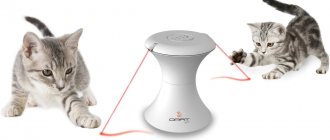Despite the ability to group well and land on their paws, falling cats from a great height is fraught with severe damage, even death. Most often, animals receive such injuries in the spring and summer, when windows are opened in multi-story buildings. Veterinarians have the term “cat high altitude syndrome,” which describes a characteristic symptom complex when animals fall from a height. According to statistics, in Moscow, about 15% of all cat injuries are caused by falling out of a window.
Injuries to cats after a fall
The most dangerous heights for falling are considered to be floors from 4 to 6, as well as above 9. In the first case, the animal manages to gain high speed, and the short time of the fall does not allow it to fully group. In the second, such a high speed is achieved that grouping the body no longer allows one to avoid injury. However, there are frequent exceptions to this rule - a fall from a great height may not cause consequences, but a flight from the 3rd floor leads to serious injuries.
Injuries typical of a cat falling from a great height:
- Cleft palate, jaw fractures.
- Internal bleeding.
- Bruises and ruptures of internal organs.
- Fractures of the limbs and spine.
- Concussion.
- Rib fractures
- Lung injuries
Often the cause of death is not the direct injury, but the subsequent shock, leading to disruption of the heart and oxygen starvation of vital organs. It is important to ensure the fastest possible diagnosis and treatment.
Symptoms of Concussion in Cats
The most telling symptom of a concussion in cats is a short-term loss of consciousness after injury. Loss of consciousness usually occurs for a couple of minutes, but coma can also occur. In this case, the following pattern is observed: the longer the cat is unconscious, the more severe its condition and consequences.
When the cat regains consciousness, it may not be oriented in space. A more rare symptom may be temporary memory loss. In this case, the animal may not recognize the owner, behave aggressively, and hide in secluded corners. A concussion in a cat is common, but the condition of your pet cannot be ignored.
First aid for a cat after a fall from a height
Once the animal is discovered, it should be taken to a veterinary clinic immediately. To do this, the cat is carefully placed on a hard surface (the bottom of a carrier, a box, a piece of plywood), moving it as little as possible. If there is no independent breathing, the animal should close its nose, pull out its tongue and inhale air through its mouth, previously covered with a cloth. The exhalation intensity is average, the exhalation is smooth, until there is a visible increase in the volume of the chest.
In case of intense external bleeding, the wound must be covered with a loose bandage or a swab made of bandage, clean fabric, or, in extreme cases, with the palm of your hand. Do not apply strong pressure. Application of a tourniquet is allowed as a last resort, in case of heavy arterial bleeding, for no more than 30-60 minutes.
Wounds, cuts, bleeding
If you have wounds or cuts after a fall, you can treat them as usual and apply an aseptic bandage. If the wounds are quite deep, it is better to immediately move towards the clinic. Your pet may need stitches.
If there is heavy bleeding, you should try to stop it by applying a tourniquet or a strong bandage. If the blood is arterial (it is much darker in appearance), then only a strong tourniquet can save your pet from fatal blood loss. However, we must remember that a limb tied with a tourniquet after two hours without blood supply can receive irreversible damage.
Therefore, after applying the tourniquet, you need to loosen the tourniquet for one minute every hour until you arrive at the clinic or the doctor arrives on call, without removing it completely. Thus, blood will gradually flow into the injured limb.
If internal bleeding is suspected, it is recommended to apply ice compresses to the cat’s tummy and head. If it is clear that the cat is in great pain, you can give a painkiller, but only the one recommended by the veterinarian, since human analgesics can lead to serious consequences under certain conditions (bleeding, internal pathologies).
Actions of the owner that are not recommended after a cat falls from the balcony
Often, first aid to a cat is provided incorrectly, as a result of which it receives additional damage that worsens the condition.
To avoid this, you should not:
- Reduce dislocations yourself, apply splints and pressure bandages.
- Trying to feed or water an animal.
- In case of loss of consciousness, revive the cat by shaking or shaking it.
- Transport the animal to the clinic while holding it in your arms.
- Performing indirect cardiac massage - due to the anatomical features of cats, it is ineffective.
- Self-administer medications without prior telephone consultation with a doctor.
Strange animal behavior
You should promptly consult a specialist if your cat exhibits the following signs:
- Uneven pupils.
- Lack of pupillary response to light stimulus.
- Rapid and unnatural eye movements.
- A cloudy spot on the pupil, trembling of the iris, an abnormal appearance of the eye associated with displacement of the lens or damage to the ligaments that support it.
- Bruising on the head.
- Too pale or, conversely, too reddened mucous membranes.
- Dizziness (its sign is an unsteady and unsteady gait).
- Headache is a sign of it: the animal rests its head on a hard surface and stands motionless.
- Drowsiness.
- Attacks of aggression.
- Involuntary twitching of paws and facial muscles.
- Paralysis of limbs.
- Short-term loss of hearing or vision.
- Difficulty in orientation.
- Increased heart rate.
- Intermittent breathing accompanied by wheezing.
You need to know that the intensity of the symptoms of a concussion in a cat directly depends on the severity of the injury and the area affected. The mechanism of brain damage during trauma is as follows: the place where the blow was directly received suffers, and after that the brain hits the opposite wall of the skull, also receiving injury. During a concussion, the hypothalamus and brain stem are most vulnerable. Brain hemorrhage is very dangerous. This condition can lead to paralysis of the animal, temporary or permanent, so it is very important to get help as soon as possible. Typically, the main symptoms in animals disappear within 2 weeks. In any case, calling a veterinarian will not hurt.
Cats falling from a height - treatment in the clinic
Upon admission to the clinic, the doctor conducts a general examination, assesses the condition, and, if necessary, carries out anti-shock therapy and uses hemostatic drugs. Then special studies are carried out - ultrasound, radiography, blood is taken for analysis. If fractures are detected, surgery is postponed for 1-3 days until the condition is completely stabilized. Immediate surgical treatment is indicated for internal bleeding and ruptures of internal organs that cannot be stopped with medication.
Cautious Actions
It should be remembered that after being injured, a cat is in a state of shock and may react hostilely to attempts to provide help. Therefore, you need to act as carefully as possible so as not to worsen the condition of your mustachioed pet.
If the cat is unconscious, it must be transported by first laying it on its side and straightening its body. In this case, it is strictly not recommended to put the pet in a carrier or transport it while holding the animal in your arms. For transportation, a flat surface must be provided. If you notice a concussion in a cat, what should you do in this situation? A veterinarian can tell you about this.
Consequences after cats fall from a height
The consequences of a fall from a height are conventionally divided into immediate - they develop a short time after the fall, and secondary, which occur after a few days.
Immediate ones include:
- Stopping breathing and heartbeat.
- Shock and collapse.
- Blood loss.
To secondary:
- Disturbances in the functioning of internal organs, most often the kidneys, liver, pancreas.
- Infection of lesions.
- Pleurisy, peritonitis.
- Fading pregnancy.
Even if the cat feels well after the fall and has no visible injuries, you should visit a doctor as soon as possible to identify hidden injuries.
Fall Prevention
Mosquito nets do not help keep a cat out of a window. They are absolutely useless and only protect against mosquitoes. These nets do not stick well to the window and are easily torn. If the cat needs it, it will jump out in no time.
Don’t rely on plastic windows with ventilation mode. This doesn't save cats. They often get stuck between the frames, receiving damage no less terrible than if they fell.
Instead of all this, special metal meshes were invented for cats. They are attached to the window very securely and do not tear. Cats can even jump and hang on them. Therefore, if you have a tailed friend living at home, such a net is vital.
A 2-month-old kitten fell from a 3-meter height
Unfortunately, in this situation, without examination it will not be possible to establish an accurate diagnosis. See a good specialist... You may also need to take blood tests and perform an ultrasound examination of the abdominal cavity and take an x-ray...
A neurological examination and x-ray of the spine and injured paw are necessary.
But the exact degree of neurological deficit and prognosis can only be determined after examination.
First, you need to find out how serious the damage to the cat’s internal organs and musculoskeletal system is; he needs intravenous drips, painkillers, anti-shock drugs, antibiotics, and hemostatic agents.
Here is a short article on this topic:
How do cats fall?
Most cats know how to regroup in flight so that they fall on their paws. But not all cats have this ability: for example, ragdolls do not know how to regroup, so for them even a fall from a wardrobe can be fatal. For others, regrouping is not a guarantee of survival.
If you compare cats and people, the difference is also in weight. After all, cats are lighter, so the impact force also decreases.
In addition, cats have an internal “device” that allows them to orient themselves in flight and rotate 180 degrees. First, the cat, turning around its axis with its paws down, stretches them out and arches its back. In this case, cats can spread out in the air like flying squirrels, like parachutists, thereby slowing down their flight speed. The tail, which is intended for this purpose, also allows maneuvering.
Once the cat has turned its paws down and assumed a position comfortable for falling, it prepares to meet the ground. First, the paws come into contact with it, as the least valuable parts of the body, then the cat’s movement towards the ground may end - then no more parts of the body will take the blow. But it happens that the shock-absorbing capacity of the paws is not enough, then the cat also hits the ground with its muzzle. Next, the torso suffers. Whether this is so or whether the cat lands on its paws and runs calmly for longer depends on many factors: its initial state, the surface under the windows, obstacles encountered during the flight and, of course, it depends on the height of the fall.
Treatment of concussion in cats, cats and kittens
Specific studies on concussion in cats have not been particularly effective. X-rays or MRIs do not provide complete information about the injury. Therefore, you should contact a qualified and experienced veterinarian who can, based on clinical data, correctly assess the cat’s condition and make a diagnosis.
The doctor first assesses the complexity of the injury and administers medications to the animal that prevent the development of cerebral edema and support the functioning of major vital functions. It should be taken into account that a strong concussion in a cat can disrupt the pet’s usual lifestyle.
Drug treatment consists of prescribing painkillers, vascular and sedatives. If the cat’s condition is severe, then additional medications are prescribed to support cardiac and respiratory activity. In case of nervous or aggressive behavior of the animal, sedatives are prescribed, which should be taken for a long time.
Much depends on the extent of damage
The first step is to assess the extent of the damage. If a cat falls from a height not exceeding the 5th floor, it can suffer minimal damage. Especially if she landed in a snowdrift, on a bush or grass. However, falling to the ground from a greater height will almost certainly require veterinary intervention.
What can happen: fracture of the spine and limbs, bleeding in internal organs, head injury and even a concussion.
How to understand the extent of damage yourself? If the paws hang motionless, this indicates severe bruises or fractures. If internal organs are damaged, there is usually bleeding from the nose, mouth or intestines, the abdomen increases in size and looks unnatural. If bones fall out or become bent, and touching becomes unbearable, this indicates the presence of fractures. In this situation, you need to urgently contact a veterinarian.
Note! Transporting a cat after a fall can be incredibly stressful and exacerbate existing problems. Therefore, it is recommended to call a veterinarian at home! The cat may also resist being touched or picked up.
Be careful not to accidentally make your pet's already difficult situation worse.
Lay your cat down after a fall without changing its body position
In any case, it may be necessary to move the cat home from the street. Under the influence of emotions, owners often make the mistake of approaching and abruptly trying to take the injured animal. The correct approach requires precision. Try to fix your head so that the cat, due to the shock it has suffered, does not instinctively bite you. Then you need to carefully place your hand, thick cloth or, ideally, a board under it. The main principle is to minimize changes in the cat's body position.
Stop the bleeding properly
Provide assistance to the best of your ability: stop the bleeding, measure the pulse and the number of respiratory movements. If, due to loss of consciousness, the animal has stopped breathing, perform artificial respiration.
The principles of assistance with bleeding are as follows:
- Apply a tourniquet, press the dressing material to the wound - a handkerchief, napkin or something similar.
- Loosen the tourniquet for a minute every hour. Then irreversible changes will not happen.
- To stop blood flowing from the veins and capillaries, a bandage is enough, but for arterial bleeding you need a tourniquet. If the blood is dark in color, this is a sign of arterial bleeding, which quickly leads to a deterioration in the cat's condition.
- If blood flows from the anus, genitals, mouth or nose, you need to immobilize the cat and apply a cold object to the corresponding area. Most often - to the head or stomach, if internal organs are injured.
Actions for vomiting and fractures: how not to worsen the situation
The correct actions of the owners before the veterinarian arrives at the house can be half the successful outcome of such an unpleasant situation as a cat falling out of a window. Let's look at a few more secrets:
Please note that your cat may choke on vomit. To prevent this from happening. you need to keep your head on the side. For fractures of the limbs, a splint should be applied (this does not eliminate the need to treat the wounds), but for fractures of the pelvis or spine, an ineptly applied splint can cause harm, so let a professional do this. Cold compresses and analgin are quite suitable as a pain reliever for a fall. In such a situation, you should not bother, water or force feed the cat.
She should be left alone, carefully laid on her side. Later, you can give small portions of food that is easily digestible
Sometimes there are no visible injuries, but you need to be examined by a veterinarian, as some may not be noticeable to the naked eye, but will appear later. Pay attention to how the temperature changes, the rhythm of breathing, how the process of urination occurs, and so on











